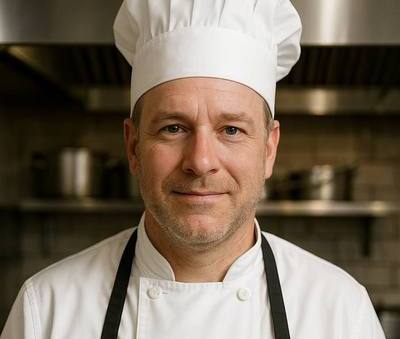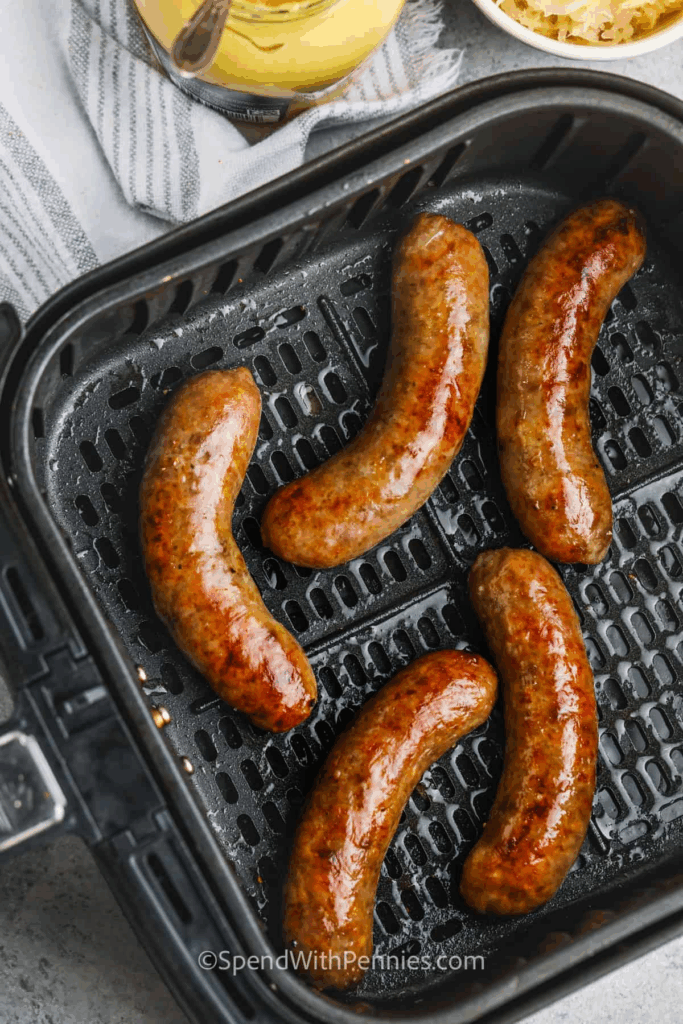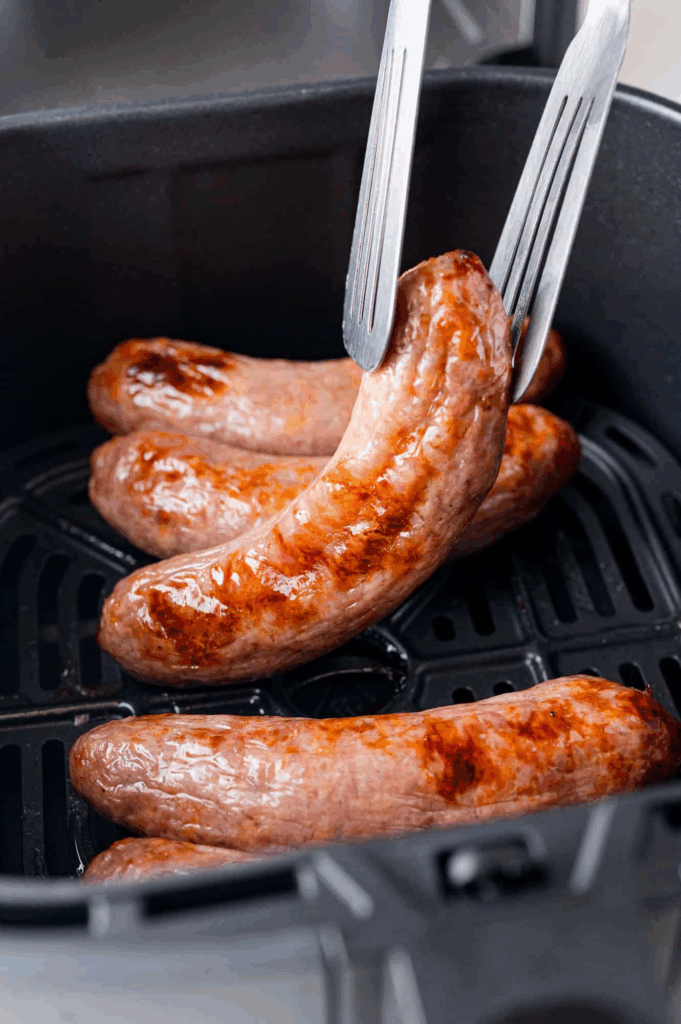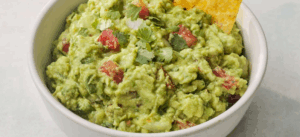How to Cook Brats in Air Fryer
How to Cook Brats in Air Fryer: Guide to Juicy Sausage with Crispy Skin

As a chef, I’ve prepared bratwurst every way imaginable—boiled in beer, grilled over charcoal, baked in ovens—but the air fryer is surprisingly one of the most efficient and consistent tools for cooking them. It delivers everything I look for: a deeply browned, crisp skin and a juicy interior, all in under 15 minutes. There’s no need for constant flipping, oil splatter, or outdoor setup. It’s indoor grilling without the hassle.
- Why the Air Fryer Is Perfect for Bratwurst
- What Are Brats? Understanding the Sausage Before Cooking
- How to Select Quality Bratwurst for Air Frying
- Preparing Brats for the Air Fryer
- Essential Ingredients for Cooking Brats in Air Fryer
- Air Frying Brats: Timing, Placement, and Turning
- Temperature and Cooking Time Table for Brats
- Cooking Frozen Brats in the Air Fryer
- Reverse Sear Brats: Air Fry First, Sear for Finish
- Sous Vide and Air Fryer Combo for Brats
- Microwave, Pressure Cooker, and Skillet Alternatives
- Common Mistakes When Cooking Brats in the Air Fryer
- Best Sauces and Mustards for Brats
- Ideal Seasonings and Sides for Brats
- Recipe Variations: Brats in Rolls, Bowls, and More
- How to Plate and Serve Brats Like a Chef
- FAQ: 15 Questions About Cooking Brats in Air Fryer — Answered by a Chef

Why the Air Fryer Is Perfect for Bratwurst
The air fryer circulates hot air rapidly around the sausage, allowing the casing to dry and tighten while the fat renders gently inside. When done right, the result is a brat that snaps when you bite into it and bursts with seasoned pork flavor. I’ve found that even frozen brats come out beautifully when handled with care and attention to temperature.
Whether you’re cooking for a quick weeknight meal or feeding a crowd on game day, brats in the air fryer are a go-to method I trust. It’s not just a shortcut—it’s a technique I’ve tested and refined to deliver results worthy of any kitchen.
What Are Brats? Understanding the Sausage Before Cooking
Bratwurst, or simply “brats,” are traditional German sausages typically made from pork, veal, or a combination of meats, seasoned with salt, white pepper, nutmeg, and sometimes coriander or marjoram. The word “bratwurst” comes from the Old High German “brät,” meaning finely chopped meat, and “wurst,” or sausage.
There are three major types I work with in the kitchen:
- Fresh brats: These are raw and require full cooking. They have the most flavor potential but also the most risk of undercooking.
- Pre-cooked brats: These are partially or fully cooked and only need reheating and crisping. I often use these when time is tight.
- Smoked brats: These have been cured and smoked, offering a deeper, bolder taste. They don’t need much cooking, just a crisp surface.
Casings are another key factor. Natural casings (from animal intestine) deliver the best snap and mouthfeel, while skinless or collagen casings are easier to handle but can turn rubbery if overcooked. Understanding what type you’re working with lets you tailor heat and timing to avoid dry, split, or greasy results.

How to Select Quality Bratwurst for Air Frying
Selecting the right brat makes all the difference. I always go for fresh, high-fat content brats—at least 25% fat—for maximum juiciness. You can usually spot a good one by its pale pink hue, firm texture, and visible flecks of fat. Anything that looks gray or overly wet is a red flag for poor freshness or water-added filler.
I also check the ingredients list if I’m not buying from a butcher. Fewer ingredients often mean better flavor. Avoid brats with excessive corn syrup, MSG, or binders unless that’s part of a specific flavor profile you want.
If you’re unsure whether the brat is fresh or pre-cooked, check the packaging. Fresh brats will often say “uncooked” or “keep refrigerated,” while pre-cooked ones will have heating instructions only. I prefer natural casing brats whenever possible, as they give that classic “snap” when air fried.
Lastly, I buy by weight. For best air fryer performance, I use brats in the 3.5 to 4.5-ounce range. Larger sausages tend to cook unevenly and risk splitting before reaching a safe internal temperature.
Preparing Brats for the Air Fryer
The first thing I always do is pat the brats dry with paper towels. Even pre-cooked ones can have surface moisture, and that inhibits browning. I never pierce the casing—ever. Piercing allows fat and juices to escape, which means dry sausage and greasy air fryer baskets. Brats are designed to cook inside their casings; let them do their job.
If I’m cooking fresh brats, I sometimes let them sit at room temperature for 15–20 minutes. This promotes more even cooking and avoids undercooked centers. I never oil the brats themselves unless I’m air frying at very high temperatures (above 390°F), and even then, just a light mist of oil helps crisp the skin without clogging the air vents.
Seasoning is optional. Traditional brats are already fully spiced inside the sausage, but if I want a flavored exterior, I roll them in paprika, fennel, or garlic powder right before air frying. I always avoid adding sugar-based glazes before air frying, as they burn quickly and stick to the basket. Those belong at the finish line.

Essential Ingredients for Cooking Brats in Air Fryer
- 4 fresh or pre-cooked bratwurst (pork or veal)
- 1 teaspoon neutral oil (optional, for higher temp crisping)
- Optional: coarse-ground black pepper, smoked paprika, garlic powder
- Optional: sliced onions or bell peppers for serving
- Optional: mustard, beer glaze, or sauerkraut for garnish
These basics allow you to control the cook, enhance flavor if desired, and plate a sausage that feels thoughtful rather than thrown together.
Air Frying Brats: Timing, Placement, and Turning
When I air fry brats, the goal is crisp, golden skin and a juicy center without bursting the casing. I always preheat the air fryer to 360°F (182°C) for 3–5 minutes before placing the brats in the basket. This jumpstart helps develop crust immediately and prevents sticking.
Brats must be placed in a single layer with space between them. Overcrowding leads to steaming, not crisping. I typically cook 4 brats at a time in a standard 6-quart air fryer. If I’m cooking a large batch, I do it in waves or rotate halfway.
For fresh brats, I cook at 360°F for 12–14 minutes, flipping once around the 6- to 7-minute mark. Pre-cooked brats take closer to 7–9 minutes total. I don’t rely on timing alone—I always check doneness with a thermometer, aiming for an internal temp of 160°F (71°C) for pork or veal.
If I’m including vegetables like sliced onions or peppers, I toss them with a bit of oil and add them during the second half of cooking. This avoids burning while letting the brats drip flavor directly into the veg.

Temperature and Cooking Time Table for Brats
This table is what I use to plan and execute bratwurst in different states—raw, cooked, or frozen:
| Brat Type | Air Fryer Temp | Time (min) | Internal Temp Goal | Chef Notes |
| Fresh (raw pork) | 360°F (182°C) | 12–14 | 160°F (71°C) | Flip halfway for even browning |
| Pre-cooked | 360°F (182°C) | 7–9 | 145°F (63°C) | Crisp casing only, do not overcook |
| Frozen, uncooked | 360°F (182°C) | 15–17 | 160°F (71°C) | May require extra minute; check for firmness |
| Frozen, pre-cooked | 360°F (182°C) | 10–12 | 145°F (63°C) | Rest briefly to equalize temperature |
I always use a meat thermometer inserted lengthwise into the center of the brat to confirm internal doneness. For visual reference, the juices should run clear and the casing should feel tight and crisp without splitting.
Cooking Frozen Brats in the Air Fryer
I’ve had to cook frozen brats more times than I can count—especially during catering setups or late prep changes. Fortunately, the air fryer handles them well if you make a few small adjustments.
First, I never preheat the air fryer when starting from frozen. I want a gentler initial heat to prevent the outside from browning before the inside thaws. I place the frozen brats into a cold basket, set the air fryer to 360°F, and cook for about 15 to 17 minutes, flipping at minute 8.
One thing I’ve learned is that frozen brats may brown unevenly. When this happens, I reduce the temperature to 340°F after flipping and extend cooking by 1–2 minutes to finish through. I also avoid poking the casing early—even if tempted to speed things up. That will release moisture and result in dry meat.
If you want to add vegetables, don’t introduce them until the last 5 minutes. Frozen brats release moisture during thawing, which can make onions and peppers soggy if added too early.
Reverse Sear Brats: Air Fry First, Sear for Finish
There’s a method I use when I want brats to really impress—especially when serving them plated, not in buns. That’s the reverse sear: air fry first to cook gently and finish with a hard sear in a skillet or under a broiler to develop an exceptional crust.
I air fry the brats at 340°F for about 10–12 minutes, just enough to bring the internal temperature close to 150°F. Then I transfer them to a hot cast-iron pan with a teaspoon of neutral oil and sear over medium-high heat for about 1 minute per side, rotating them to brown evenly.
Alternatively, I place them under a broiler set to high for 90 seconds per side, about 6 inches from the element. This creates deeper caramelization and brings the brat to a final internal temp of 160°F.
This method is ideal when I’m serving brats sliced, plated with mustard aioli or in elevated formats like with roasted fingerlings or braised cabbage.
Sous Vide and Air Fryer Combo for Brats
When I want perfect doneness from edge to edge—and time to prep other dishes without pressure—I use a sous vide + air fryer combo. I vacuum seal fresh brats with garlic, thyme, and a touch of beer or cider, then cook them in a sous vide bath at 150°F (66°C) for 1 hour.
After that, I remove them from the bag, pat them dry thoroughly, and air fry at 400°F for 5 minutes, flipping once. This crisps the casing without cooking the inside any further.
The benefit of this combo is control. Sous vide eliminates the risk of undercooking, and the air fryer gives me surface texture without needing a pan. It’s a method I often use when serving brats alongside plated brunch items or German-style samplers, where clean execution matters.
Microwave, Pressure Cooker, and Skillet Alternatives
When I don’t have access to an air fryer, I fall back on other reliable methods. The skillet is my next-best option. I add a small splash of water to the pan, cover, and let the brats steam on medium-low heat for 5–7 minutes, then remove the lid and sear until golden, flipping occasionally. This method mimics air fryer texture surprisingly well.
The oven is slower but solid. I place the brats on a rack over a sheet pan, roast at 375°F (190°C) for 20–22 minutes, flipping once. It won’t crisp the casing like air frying or pan searing, but it gives an evenly cooked interior.
Microwave cooking, on the other hand, is something I only use for reheating. I wrap leftover brats in a damp paper towel, microwave at 50% power for 1–2 minutes, and finish with a sear if possible. It’s never my first choice, but it works in a pinch.
The pressure cooker is tricky. It’s better for braised sausages. I’ve used it by adding beer or broth, cooking at high pressure for 5 minutes, and finishing in a hot skillet. This delivers incredible tenderness but doesn’t offer crisp casing without that final sear.
Common Mistakes When Cooking Brats in the Air Fryer
The most common mistake I see is overcooking—especially with pre-cooked brats. People assume they need 15 minutes, but all that does is dry out the meat and split the casing. I always recommend using a thermometer and removing them at 160°F internal.
Another issue is crowding the basket. When brats are packed too tightly, the air doesn’t circulate, and you end up with pale, steamed sausages instead of crisped beauties. I always give each one breathing room, even if that means cooking in batches.
Piercing the casing is another big no. While some think it helps release fat or pressure, it actually leads to dry, flavorless brats and excess grease at the bottom of the fryer. Keep them whole—the casing is there for a reason.
Lastly, many forget to dry the brats. Even just a few drops of surface moisture can interfere with browning. A paper towel blot before cooking makes a world of difference.
Best Sauces and Mustards for Brats
Sauces are what elevate brats from backyard fare to chef-quality plates. My personal favorite is coarse-ground Dijon mustard, often blended with a touch of honey and cider vinegar for balance. It cuts through the richness of the sausage without overpowering it.
When I want something heartier, I make a beer mustard reduction—by simmering brown mustard, a malty lager, and shallots until thickened. It pairs beautifully with grilled onions and roasted potatoes.
For a creamy option, I mix whole grain mustard with crème fraîche or Greek yogurt, plus lemon zest and chives. It’s tangy, cool, and excellent on top of sliced or bunless brats.
If I’m serving brats as an entrée, I sometimes spoon a warm apple cider glaze or balsamic onion jam alongside. These sweet-savory accents bring out the meatiness of the sausage and work well with sautéed greens or cabbage.
Ideal Seasonings and Sides for Brats
Brats come well-seasoned from the inside, so I rarely need to add anything except maybe cracked pepper, fennel seed, or smoked paprika on the surface. These seasonings toast well during air frying and enhance the exterior without masking the original profile.
For sides, I pair brats with sharp or acidic components to cut through the fat. Sauerkraut, especially warmed with caraway and onion, is a classic. I also love pickled red cabbage, German potato salad, or even crispy smashed potatoes with herbs.
In warmer seasons, I go lighter—shaved cucumber-dill salad, roasted peppers, or even grilled corn add brightness. I avoid overly sweet pairings like brown sugar beans unless balanced with vinegar or spice.
Presentation counts. I scatter chopped herbs, a swipe of mustard on the plate, and maybe a few blistered cherry tomatoes or charred scallions. Brats may be rustic, but they deserve polish.
Recipe Variations: Brats in Rolls, Bowls, and More
One of the best things about air-fried brats is their versatility. I’ve used them in everything from classic buns with sauerkraut to low-carb bowls with roasted vegetables and mustard vinaigrette.
Sliced brats are great in grain salads with farro, arugula, and lemon dressing. Or I sauté them with onions and peppers, serve over buttered noodles, and top with herbs and crispy breadcrumbs.
For brunch, I chop brats and cook them into frittatas, or fold them into savory pancakes with mustard maple syrup. They also work beautifully in sheet pan bakes with potatoes, apples, and red onion.
One trick I love is slicing cooked brats into coins and pan-crisping them, then tossing them into mac and cheese or serving on crostini with mustard aioli and chives for elevated appetizers. Brats aren’t just sausage—they’re a building block.
How to Plate and Serve Brats Like a Chef
Brats may be humble, but how you serve them makes all the difference. When I plate them for casual meals, I keep things hearty and clean—whole sausages in lightly toasted buns, mustard swiped directly on the bread, a pile of sautéed onions, and a spoonful of tangy kraut. I choose buns with structure—brioche or pretzel rolls that hold heat and sauce without collapsing.
When plating for a more refined setting, I slice the brat on a bias into thick coins or angles, fan them out on a hot plate, and nest them over mustard-laced mashed potatoes, cider-glazed cabbage, or caramelized onions. I finish the plate with a few scattered microgreens or crispy shallots, a drizzle of herb oil or mustard cream, and just a hint of acid—like cider vinegar or lemon zest.
Presentation isn’t about being fancy—it’s about intentionality. Clean edges, contrast in color and texture, and even spacing turn brats into something that feels special, even if they were made in an air fryer. Whether it’s a brunch board, a beer dinner, or a Tuesday night, make it count on the plate.
FAQ: 15 Questions About Cooking Brats in Air Fryer — Answered by a Chef
Do I need to preheat the air fryer for brats?
From experience, yes. A preheated air fryer starts the browning process instantly and prevents sticking. I always preheat for at least 3 minutes at the target cooking temperature.
Can I cook frozen brats in the air fryer?
I’ve done it many times. I recommend starting in a cold basket, using 360°F for 15–17 minutes, and flipping halfway. The key is not rushing the first few minutes—let them thaw gradually.
Should I pierce the casing?
I never do. Piercing releases fat and moisture, which leads to dry sausage and splattering. I’ve tested both ways, and whole, unpierced brats are always juicier and better textured.
What’s the best air fryer temperature for brats?
For fresh brats, I cook at 360°F for a balance of interior doneness and exterior crisping. Higher temps risk bursting the casing, and lower temps don’t crisp properly.
Can I stack brats in the air fryer?
I’ve tried, but I don’t recommend it. They won’t cook evenly or crisp. Always cook in a single layer, and if you need more, work in batches—it’s worth the wait.
How do I know brats are done without a thermometer?
I always use a thermometer, but if I had to guess, I look for firm texture, slight casing resistance, and clear juices. That said, it’s far more reliable to check for 160°F internal temp.
What oil should I use, if any?
Brats have enough fat, but I sometimes use a light spritz of avocado or canola oil for extra browning. Don’t coat them heavily or the casing gets greasy, not crisp.
Can I reheat cooked brats in the air fryer?
Yes, and I often do. I reheat at 330°F for 5–6 minutes, flipping once. It brings them back to life without drying them out, especially if they were sliced and stored cold.
What sides go best with air fryer brats?
I recommend pairing them with acidic or starchy sides: sauerkraut, vinegar slaw, roasted potatoes, mustard greens, or pretzel bread. These contrast the fat and round out the meal.
Can I cook brats and veggies at the same time?
Yes, but stagger the timing. I start the brats first, then add oiled veggies (like sliced peppers or onions) halfway through. That way everything finishes at the same time, perfectly.
How do I prevent brats from splitting?
Lower cooking temperature, gentle handling, and not overcrowding the basket are key. I also never prick the casing. When they split, it’s usually from overheating too fast.
What if my brats are too pale after air frying?
Give them a 1-minute pan sear or a quick blast under a broiler. I’ve used both methods to recover brats that lacked color—it adds visual appeal and crispness instantly.
Is it okay to use flavored or cheese-filled brats in the air fryer?
Absolutely. Just reduce cooking time slightly and watch closely—the cheese can bubble out and burn. I prefer to line the basket with parchment or foil when using stuffed brats.
What’s your favorite way to serve brats?
I love slicing them into bias-cut pieces and serving them over warm sauerkraut with mustard cream and crushed pretzels on top. It’s rustic, rich, and always a crowd-pleaser.
Can I cook brats ahead and reheat later?
Definitely. I often do this for events. I undercook slightly (pull at 150°F), chill, then reheat in the air fryer or a covered skillet. It keeps them juicy and saves time under pressure.




Post Comment